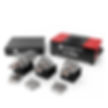Hall Effect Measurement System (HEMS)
- NanoMagnetics Instruments
- Apr 19, 2022
- 4 min read
Updated: Oct 17, 2022
In this post, you can find:
What is a Hall Effect Measurement System (HEMS)?
The HEMS systems have an integrated hardware and software system designed to measure and analyze the electronic properties of samples.
The system design offers the possibility to take measurements under the magnetic field up to 2.5 Tesla.
At the same time, the system offers the opportunity to take measurements in the range of 3K-1273K with 2 different temperature measuring heads, while it provides an easy assembly of samples related to the probe system that can move in 3 different axes.
NMI – Hall Effect Measurement System (HEMS) device Performs electrical characterization of semiconductor, organic conductor and metal oxide materials. These materials developed with nanotechnology methods are used in the development of chip technology, the development of solar cells, the development of material science, space technology, defense industry.

What is ezHEMS?
The ezHEMS device, a more portable version of HEMS (Hall Effect Measurement System) devices used worldwide. Due to the system design, there are two different magnetic field options with permanent magnets. Permanent-magnet based configurations provide fields to 0.6T or fields to 1T available in the standard system.
The system include “Low temperature measuring head-LT”, “High Temperature Measuring Head-HT” and “Room Temperature Head-RT” between 4K and 800K temperatures. The design of the low temperature measuring head enables the cooling process to be taken at a lower cost by using liquid nitrogen (LN2 / no cryogen-free).
At the same time the system include the specimen area that is easily positioned into the system with the 3-dimensional moving probe system inside the measurement head.
The controller of the system is designed for easy and precise operation in the current range of +/- 2nA to +/- 20mA.
Through to the design, all connections can be made between the system parts with two cables with connector terminals, and only one USB cable is required between the system and the computer.
The LabView-based software of the ezHEMS device enables smooth operation on the Windows ® operating system.
Additionally, the ezHEMS device has been manufactured in accordance with ASTM standards.

What are ASTM standards?
You've definitely come across ASTM standard definitions in your metalworking career. ASTM B194 for beryllium copper and ASTM B103 for phosphor bronze can be seen on labels, but what exactly are ASTM standards?
ASTM safety standards are essential for ensuring that materials are of good quality and work as they should in your business. We'll take a quick look at what ASTM stands for and why it matters to you.
What does ASTM mean?
ASTM International, originally known as the American Society for Testing and Materials, is a global leader in the development of voluntary consensus standards that are utilized by individuals, businesses, and other organizations all over the world. Over 30,000 voluntary members from over 140 countries make up ASTM.
The organization satisfies the World Trade Organization's criteria for international standard-setting bodies. The ASTM elects a board of directors to manage and make decisions on behalf of the entire membership.
How are ASTM safety standards developed?
A standard is a written document that specifies the quality and safe usage of materials from a variety of industries, including metals, paints, plastics, textiles, petroleum, and consumer goods. This information is provided by ASTM. It lays forth these distinguishing traits and tests in order to determine which items should meet the criteria.
Any interested party can submit a request to ASTM International for a new standard. A draft of the standard is prepared by an ASTM technical committee, which is then sent to a parent subcommittee for approval before being made accessible to all members for evaluation. Before the document can continue on to the next level, any objections raised during the process must be evaluated.
After ensuring that ASTM protocols were followed appropriately and the standard was given due process, the ASTM International Committee on Standards grants final approval. This due process ensures that all interested parties have a say and that opposing interests are balanced.
ASTM safety standards are used by scientists, engineers, architects, and government bodies to ensure the quality and consistency of materials. While these criteria are voluntary, they must be cited in contracts, government rules, regulations, or laws by authorities.
Metals' material, chemical, mechanical, and metallurgical qualities are all evaluated using ASTM standards. This data assists product makers in developing correct processing and application techniques. The ASTM website allows institutions and individuals to search for over 12,000 standards in any industry.
Where can I buy a HEMS device?
If you are looking for a high-quality HEMS device, you can check NanoMagnetics Instruments' ezHEMS or HEMS.
Contact us to get a quote for HEMS/ezHEMS.
Frequently asked questions about Hall Effect Measurement Systems
What does a Hall effect measurement measure?
A tool that is used to gauge the strength of a magnetic field is a Hall effect sensor.
What is Hall effect used for?
The Hall effect can be used to detect the presence of a current on a magnetic field as well as to assess the density of current carriers, their freedom of movement, or mobility.
Why do we measure Hall coefficient?
The magnetic field or the carrier density can both be measured extremely effectively using the Hall effect. The Hall effect distinguishes between positive charges travelling in one direction and negative charges moving in the opposite, which is one of its key characteristics.
How do you identify a semiconductor for a Hall effect?
By using the Hall Effect, we may quickly determine if a semiconductor is p-type or n-type. The material is referred to as being p-type if the voltage produced is positive, and n-type if the voltage produced is negative.
